|
|
|
Sort Order |
|
|
|
Items / Page
|
|
|
|
|
|
|
| Srl | Item |
| 1 |
ID:
133474
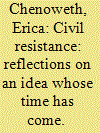

|
|
|
|
|
| Publication |
2014.
|
| Summary/Abstract |
IT HAS BEEN THREE YEARS SINCE WHY CIVIL RESISTANCE WORKS HIT THE shelves.1 When Maria J. Stephan and I sent the final galleys into the publisher, we had no idea that the Arab Spring was about to grip the world; that the Occupy movement would reenergize the protest sector in advanced
democracies; or that countries as diverse as Turkey, Venezuela, Ukraine, Thailand, and India would be rocked by nonviolent resistance against entrenched authority, lack of economic opportunity, and corruption. While many people have cataloged the global decline in armed conflict, few have noticed that, in the meantime, the use of civil resistance has been on the rise.
|
|
|
|
|
|
|
|
|
|
|
|
|
|
|
|
| 2 |
ID:
132148
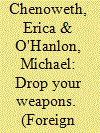

|
|
|
|
|
| Publication |
2014.
|
| Summary/Abstract |
Over the past three years, the world has witnessed a surge of nonviolent resistance movements. Pictures of huge demonstrations in public squares have become a staple of international news broadcasts, and Time named "the protester" as its Person of the Year for 2011. These days, it seems that at any given moment, thousands of people are mobilizing for change somewhere in the world.
|
|
|
|
|
|
|
|
|
|
|
|
|
|
|
|
| 3 |
ID:
160474
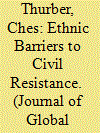

|
|
|
|
|
| Summary/Abstract |
While ethnic cleavages have featured prominently in our understanding of civil wars, attention to ethnic and social structures has been surprisingly absent from the recent wave of research on civil resistance. Yet these structures likely have an important impact on when and where we see nonviolent campaigns occur. This article argues that the strategic logic of civil resistance presents high barriers to entry for politically excluded ethnic minorities. Constraints on these groups’ ability to activate mechanisms central to an exclusively nonviolent strategy either prevent them from getting a civil resistance campaign off the ground or deter them from ever attempting to do so. Using original data on the ethnic composition of nonviolent and violent campaigns, I show that nonviolent campaigns are less likely than violent ones to include participants from politically disadvantaged ethnic groups and also less likely to feature ethnic political claims. Furthermore, I find that political exclusion and small group size reduce the likelihood that members of an ethnic group will initiate a campaign of civil resistance.
|
|
|
|
|
|
|
|
|
|
|
|
|
|
|
|
| 4 |
ID:
166671
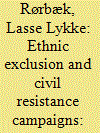

|
|
|
|
|
| Summary/Abstract |
Previous research has argued that political inequality between ethnic groups increases the likelihood of both nonviolent and violent protest. In this study, I focus on civil resistance campaigns and argue that the probability that these large-scale, organized movements will take violent over nonviolent forms increases with the share of a country’s population that is excluded from political power on the basis of ethnic affiliation. I expect this to be so because ethnically exclusive regimes are more likely to counter political demands with violent repression, which increases the cost and decreases the anticipated success of nonviolent relative to violent resistance. I test this proposition in a global sample of countries for the period 1950–2006 and find, first, that high levels of ethnic exclusion make civil resistance campaigns more likely to occur violently than nonviolently. Next, to assess the mechanism at play, I conduct a mediation analysis and show that almost half of the effect of ethnic exclusion on violent campaign onset is mediated by the latent level of violent repression in a country. This result suggests that political authorities’ repressive strategies are key to explaining why regime opponents do not always opt for nonviolent forms of civil resistance.
|
|
|
|
|
|
|
|
|
|
|
|
|
|
|
|
| 5 |
ID:
160475
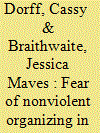

|
|
|
|
|
| Summary/Abstract |
What drives perceptions of fear regarding nonviolent mobilization? We investigate whether this fear is more acute in certain segments of society, or whether such concerns are randomly distributed across the population. We anticipate that civilians living in proximity to armed resistance groups are especially afraid of being targeted if they organize nonviolently against insecurity in their community. Using original survey data from Mexico in early 2014, we examine civilian perceptions of risk associated with nonviolent action. Quantitative analyses provide support for our expectation that civilians living in proximity to armed vigilante groups are more fearful of participating in nonviolent action. This suggests that organizers of civil resistance in Mexico (and similar conflict environments) would do well to consider the challenges posed by civilian vigilantism when seeking to mobilize civilians and selecting specific nonviolent strategies for high-risk constituencies.
|
|
|
|
|
|
|
|
|
|
|
|
|
|
|
|
| 6 |
ID:
186813


|
|
|
|
|
| Summary/Abstract |
Do more protesters on the streets make governments likely to grant their demands? Several studies link protest size and government concessions. Yet existing research has limitations: many studies suffer from potential endogeneity due to potential protesters joining protests when they anticipate that concessions are likely, causal mechanisms are often unclear, and many of the most rigorous event-level studies are limited to Western democracies. We reexamine this relationship in a non-Western sample using a novel instrumental variable approach, using Fridays as an instrument for exogenous variation in protest size in predominately Muslim countries. We perform two analyses: one using the NAVCO 3.0 dataset, and the second using the Mass Mobilization in Autocracies Dataset (MMAD). In both analyses exogenous variation in protest size negatively affects the likelihood of concessions. Larger protests are less likely to receive government concessions. We suggest these surprising results point to the importance of unanticipated protests that produce new information about regime stability to motivate government concessions.
|
|
|
|
|
|
|
|
|
|
|
|
|
|
|
|
| 7 |
ID:
154067
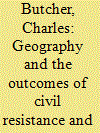

|
|
|
|
|
| Summary/Abstract |
This paper reports the results of the first cross-national examination of the impact of the geography of nonviolent contention on regime transitions. Nonviolent tactics ‘work’ in part by signalling the preferences of non-participants through the symbolism of participants, unlike violent tactics. This opens the way for nonviolent campaigns to exploit variations in social-spatial meaning to enhance the informativeness of dissent. Capital cities are one such symbolic place and the main prediction of this study is a positive relationship between large protests and regime transitions in the capital, but not elsewhere. I also predict a strong direct relationship between the proximity to the capital of fighting in civil wars, and regime transitions; no relationship to the proximity of nonviolent contention; and that the intensity of violent conflict impacts regime transitions in a way that is largely independent of location. Results from an analysis of episodes of violent and nonviolent conflict from 1990 to 2014 generally support these contentions.
|
|
|
|
|
|
|
|
|
|
|
|
|
|
|
|
| 8 |
ID:
161553
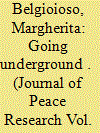

|
|
|
|
|
| Summary/Abstract |
When and why do groups participating in mass dissent choose to initiate terrorist campaigns? I argue that groups involved in civil wars and mass civil resistance might face similar organizational pressures, which encourage the initiation of terrorism due to higher tactical effectiveness. Internal organizational pressure might depend on leaders’ expectations of a decline in followers’ commitment with protracted use of mass tactics. This is likely to motivate leaders to initiate terrorist campaigns to secure organizational survival. External organizational pressures might depend on increasing dissident campaigns’ fragmentation. This intensifies competition making leaders more likely to initiate terrorism so as to establish themselves at the forefront of their movements. The findings provide empirical support consistent with my claims and indicate no significant difference between civil wars and mass civil resistance movements with regards to these effects. Contrary to the common idea that the use of conventional violence should entail a higher willingness to engage in illegal violence against non-combatants, this finding suggests that conflict dynamics affect the decision to initiate terrorism and that terrorist campaigns have a coherent strategic logic across different types of mass dissent.
|
|
|
|
|
|
|
|
|
|
|
|
|
|
|
|
| 9 |
ID:
172366
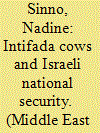

|
|
|
|
|
| Summary/Abstract |
The Wanted 18 narrates the story of a Palestinian town whose residents assert their autonomy by purchasing 18 cows and producing their own milk during the first intifada. In response, the Israeli military declares the cows a ‘threat to the security of Israel’ and hunts down the ‘wanted 18.’ This article provides an analysis of The Wanted 18, focusing on the human-animal interactions. It demonstrates how film directors Amer Shomali and Paul Cowan deploy animal protagonists as a means of exposing anti-Palestinian prejudice, critiquing Israeli occupation and the Palestinian authorities who undermined civil resistance during the first intifada, and elucidating the transformative impact of human-animal companionship and creative resistance in a humorous manner that appeals to a global audience.
|
|
|
|
|
|
|
|
|
|
|
|
|
|
|
|
| 10 |
ID:
173901
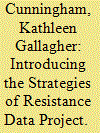

|
|
|
|
|
| Summary/Abstract |
This article introduces the Strategies of Resistance Data Project (SRDP), a global dataset on organizational behavior in self-determination disputes. This dataset is actor-focused and spans periods of relative peace and violence in self-determination conflicts. By linking tactics to specific actors in broader campaigns for political change, we can better understand how these struggles unfold over time, and the conditions under which organizations use conventional politics, violent tactics, nonviolent tactics, or some combination of these. SRDP comprises 1,124 organizations participating in movements for greater national self-determination around the world, from 1960 to 2005. Despite the fact that few self-determination movements engage in mass nonviolent campaigns, SRDP shows that more organizations employ nonviolent tactics at some point in time (about 40%) than employ violence (about 30%). Many organizations switch among tactics or use both at the same time. This dataset will allow analysts to examine the use of different combinations of tactics and patterns of change. We compare the data with the most-used dataset on nonviolence, the NAVCO 2.0 Data Project, to demonstrate what we gain by employing an organization-level dataset on tactics. We present a set of descriptive analyses highlighting the utility of the SRDP, including an examination of tactic switching. We show that more organizations change from violence to nonviolence than the reverse – challenging the widely held assumption that organizations ‘resort’ to violence. SRDP allows scholars to examine organizational choices about tactics, and trends in these tactics, with much greater nuance.
|
|
|
|
|
|
|
|
|
|
|
|
|
|
|
|
| 11 |
ID:
192843
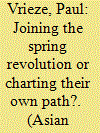

|
|
|
|
|
| Summary/Abstract |
This article examines Myanmar ethnic minorities’ diverse responses to the 2021 military coup. The coup prompted widespread mobilization for a national alliance that aims to replace the junta with a federal democracy. For minority actors this resistance could offer a unique opportunity to advance their demands for political autonomy, yet their responses diverged. Some joined the alliance; others declined, or accepted junta offers. Based on original interviews, this analysis unpacks the positions of ethnic rebels, civil society organizations, and parties. It suggests rebels’ strategies were influenced by their relations with civil society and military strength. Most ethnic parties avoided resistance, as they feared junta retaliation and distrusted the ousted National League for Democracy. Ethnic civil society organizations played a key coordinating role during alliance formation, enabled by its campaign experience and networks. The article’s insights into interethnic cooperation and minorities’ varied situations can benefit international actors seeking resolutions of Myanmar’s post-coup conflict.
|
|
|
|
|
|
|
|
|
|
|
|
|
|
|
|
| 12 |
ID:
179366
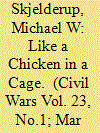

|
|
|
|
|
| Summary/Abstract |
This article explores civilian agency and civil resistance under Islamist insurgents’ rule in southern Somalia in the period 2006 to 2012. After almost two decades of civil war, local institutions were weakened and the communities could not resist tight Islamist control. The traditional authorities either fled or chose to cooperate with the new rulers. However, while treading a fine line, traditional authorities were still able to raise community concerns and influence the Islamist rulers’ behaviour through limited forms of civil resistance. Although not changing the overall political situation, traditional authorities were instrumental in reducing tension and improving civilian life.
|
|
|
|
|
|
|
|
|
|
|
|
|
|
|
|
| 13 |
ID:
182663
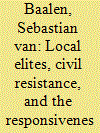

|
|
|
|
|
| Summary/Abstract |
Why is rebel governance more responsive in some areas than in others? In recent years, scholars have started to examine the determinants of rebel governance. Less attention has been given to explaining variation in the responsiveness of rebel governance, that is, the degree to which rebels are soliciting and acting upon civilian preferences in their governance. This article seeks to address this gap by studying local variation in rebel responsiveness. I argue that rebel responsiveness is a function of whether local elites control clientelist networks that allow them to mobilize local citizens. Strong clientelist networks are characterized by local elite control over resources and embeddedness in local authority structures. In turn, such networks shape local elites’ capacity for mobilizing support for, or civil resistance against, the rebels, and hence their bargaining power in negotiations over rebel governance. Drawing on unique interview and archival data collected during eight months of fieldwork, as well as existing survey data, the study tests the argument through a systematic comparison of four areas held by the Forces Nouvelles in Côte d’Ivoire. The analysis indicates that the strength of local elites’ clientelist networks shapes rebel responsiveness. Moreover, it provides support for the theorized civil resistance mechanism, and shows that this mechanism is further enhanced by ethnopolitical ties between civilians and rebels. These findings speak to the burgeoning literature on rebel governance and to research on civil resistance. In addition, the results inform policy debates on how to protect civilians in civil war.
|
|
|
|
|
|
|
|
|
|
|
|
|
|
|
|
| 14 |
ID:
120770
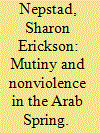

|
|
|
|
|
| Publication |
2013.
|
| Summary/Abstract |
Recent studies of civil resistance indicate that security force defections can heavily influence the outcome of nonviolent uprisings against authoritarian regimes. Yet we know little about why, when, and how mutiny occurs. In this article, I ask: what factors influence the likelihood of military defections during a nonviolent conflict? In reviewing various literatures, I identify ten factors that facilitate or obstruct mutiny. I propose that two of these are particularly influential: (1) whether troops receive economic or political benefits from the regime; and (2) whether troops perceive the regime as fragile, based on the international community's response to the conflict. Specifically, I argue that troops who receive benefits from a regime are more likely to remain loyal while those who receive no such benefits are more likely to defect. However, even the most underprivileged troops are unlikely to defect if they believe that the state is strong enough to withstand a major civilian uprising. Soldiers' perception of regime strength is partly shaped by whether outside nations support the opposition, thereby weakening the state, or send troops to reinforce the regime's control. Using a qualitative comparative method, I illustrate these dynamics through an examination of several Arab Spring uprisings: Egypt, where the military sided with civil resisters; Bahrain, where troops remained loyal to the state; and Syria, where the military split. Then, to encourage more research on this topic, I use these three cases to generate additional hypotheses about defections that others can test against a wider set of cases. I conclude with a discussion of the questions that future researchers should explore and the types of methodological approaches that are needed in this field of study.
|
|
|
|
|
|
|
|
|
|
|
|
|
|
|
|
| 15 |
ID:
186355
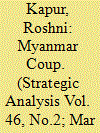

|
|
|
|
|
| Summary/Abstract |
Myanmar has been in a turmoil since the Tatmadaw (country’s military) ousted Aung San Suu Kyi’s government and seized power in February 2021.1 The coup took place hours before the new parliament could convene following the 2020 general elections. The junta has detained her since then and reimposed military rule after running a short experiment under a power-sharing arrangement with the National League for Democracy (NLD).2 There are concerns that Myanmar could morph into another Syria with widespread displacement and hunger, aggravated by the COVID-19 pandemic. This commentary explores the sustained crackdown by the junta, the painstaking efforts undertaken by the ousted government to remain relevant domestically and gain legitimacy abroad, how the Tatmadaw is currently fighting a multi-front war in several areas of the borderlands, the adoption of violent tactics by members of the civil disobedience movement and ASEAN’s inability to find a permanent solution to the worsening crisis in Myanmar.
|
|
|
|
|
|
|
|
|
|
|
|
|
|
|
|
| 16 |
ID:
185208
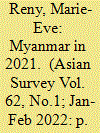

|
|
|
|
|
| Summary/Abstract |
Parliament did not have a chance to convene under the newly elected National League for Democracy administration. Before the first parliamentary session was to take place in early February, the military detained the leaders of the incoming administration and took control of the executive. It justified its actions by saying elections in November 2020 were fraudulent and the Union Election Commission had refused to investigate possible irregularities in the vote. Although the military said new elections would be held within two years, its rule might not be temporary.
|
|
|
|
|
|
|
|
|
|
|
|
|
|
|
|
| 17 |
ID:
182664
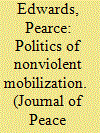

|
|
|
|
|
| Summary/Abstract |
Nonviolent resistance is considered one of the most effective methods of bringing about political change. Yet empirical research on how nonviolent campaigns emerge is limited. This article considers two sets of considerations which influence the strategic decision of a campaign to use nonviolent or violent methods: interactions with the state and campaign resources. Campaigns are concerned about the risk of repression from the state and are more likely to choose nonviolence when they believe the state will accommodate their demands. Open political competition signals likely accommodation. Campaigns’ nonviolent tactics are more effective when they possess social movement resources, though high levels of movement resources threaten the state. The argument implies political competition and social movement resources are associated with a higher likelihood of a campaign using nonviolence, though the relationship with social movement resources diminishes at high levels. Implications of the argument are tested on a sample of contentious campaigns from 1945 to 2006. Political competition and social movement resources are related as expected to the use of nonviolence. However, an extension shows these factors do not account for the advantage of nonviolent methods, particularly in triggering backlash protests, once a campaign is under way. An original ordinal measurement strategy for campaign methods suggests the intensity of violence and nonviolence are likewise unrelated to competition and resources.
|
|
|
|
|
|
|
|
|
|
|
|
|
|
|
|
| 18 |
ID:
120766
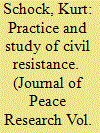

|
|
|
|
|
| Publication |
2013.
|
| Summary/Abstract |
This article provides an overview of the practice and study of civil resistance. First, historical roots of modern civil resistance are discussed, including the emergence in the 19th century of mass-based campaigns of non-cooperation to promote nationalist and labor interests, as well as the significance of Mohandas Gandhi and the widespread use of nonviolent resistance in the 20th century. Second, perspectives of scholars of social movements and revolution are compared with those of scholars who focus more specifically on nonviolent resistance. Despite studying much of the same phenomena, separate literatures have developed that are ripe for cross-fertilization and synthesis. In the third section, a literature review is organized around three key concepts for understanding civil resistance: mobilization, resilience, and leverage. Fourth, consequences of nonviolent resistance relative to violent resistance are discussed. Finally, areas for future research are identified.
|
|
|
|
|
|
|
|
|
|
|
|
|
|
|
|
| 19 |
ID:
189009
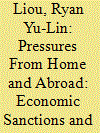

|
|
|
|
|
| Summary/Abstract |
What effect do economic sanctions have on target governments’ response to citizen campaigns? We assert that sanctions as a signal of international support for campaigners alter the bargaining environment between a target state and the campaign in ways that will likely draw more support from citizens and defections from the ruling base. This will in turn incentivize target leaders to be more conciliatory toward domestic campaigns with maximalist goals, especially when such campaigns are nonviolent. Results from a time-series, cross-national data analysis indicate that sanctions, particularly when they are enforced by multiple senders or with high cost, are effective in increasing the success rate of nonviolent campaigns. Given the plethora of sanctions research that points to their inefficacy and adverse effects, we show that sanctions could be an effective tool to extract concessions from governments facing nonviolent campaigns.
|
|
|
|
|
|
|
|
|
|
|
|
|
|
|
|
| 20 |
ID:
176191
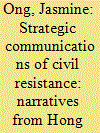

|
|
|
|
|
|
|
|